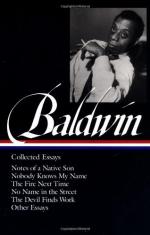|
This section contains 3,377 words (approx. 12 pages at 300 words per page) |

|
James Baldwin has made a reputation by exploiting social paradoxes, so it should not be surprising to trace his literary antecedents to neither Richard Wright nor Harriet B. Stowe, but to that Brahmin, Henry James…. The amphibian elegance of [Baldwin's] syntax comes naturally to an artist obsessed by dualities, paradox. The Atlantic Ocean separated James's mind into opposed hemispheres, and the gulf of color so cleaves Baldwin. The antipodes of their worlds propose a dialectical art. (p. 52)
Baldwin's characters suffer no more from their color than James's suffer from their money—these are only the peculiar conditions of their suffering. The problem for both is more universal—the opacity of their culture and the question of their identity within it. For Baldwin assumes, in the consequences of his culture, the crisis of his identity, the reflective burden of Western Man. His color is his metaphor, his vantage. But...
|
This section contains 3,377 words (approx. 12 pages at 300 words per page) |

|


